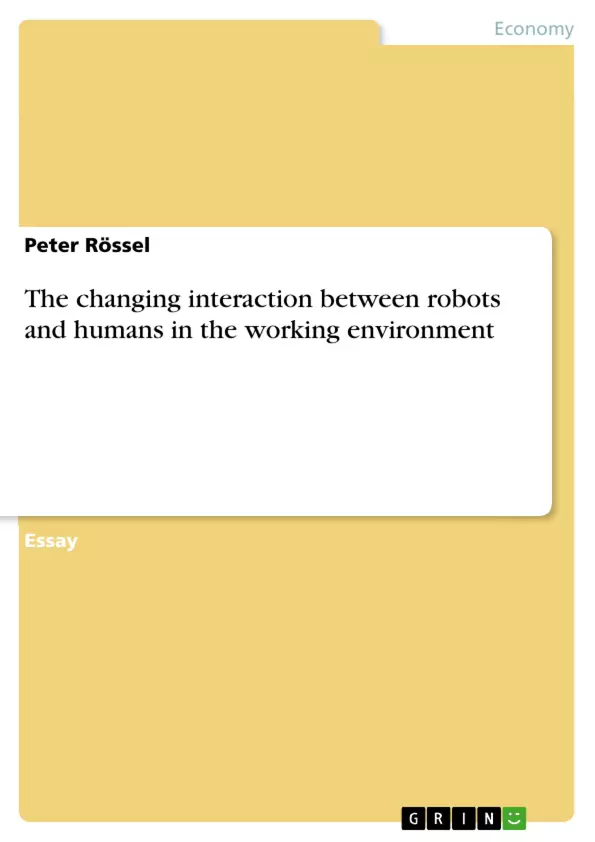Within my research paper I analyze how the further development of robotic devices will influence our working environment.
Robots are going to change the global economy drastically. With severe effects on the job market, as recent studies outline. In the United Kingdom alone one third of jobs could be omitted due to the “robot-revolution”, in the United States with 47 percent even almost half. Especially in “low-skilled” job fields robots could take many working spaces of human beings, enormous social shifts would result.
Even though a lot of people argue that technical advancement and therefore the further development of robotic devices bring advantages to our lives for the most part, we have to start to realise that robots may replace our jobs and therefore adapt to a changing work environment. More and more people are outcompeted by a non-living species an, unlikeable scenario that though will take place in the future and therefore people have to learn to deal with this new setting.
Inhaltsverzeichnis (Table of Contents)
- Introduction
- The changing working environment
- How Robots replace Jobs
- The new life-style
- New requirements
Zielsetzung und Themenschwerpunkte (Objectives and Key Themes)
This text explores the potential impact of robotics and automation on the global economy and workforce. It examines the changing working environment, the ways in which robots are replacing jobs, and the new requirements and challenges that these developments bring.
- The impact of robotics and automation on the job market
- The changing nature of work and the rise of new job opportunities
- The need for adaptability, lifelong learning, and flexibility in the face of technological change
- The potential for social upheaval and economic inequality as a result of automation
- The importance of finding a balance between technological advancement and human well-being
Zusammenfassung der Kapitel (Chapter Summaries)
Introduction
This chapter introduces the topic of robotics and automation, highlighting their potential to drastically alter the global economy and job market. It cites studies showing significant job displacement in countries like the UK and the US, particularly in low-skilled sectors. The chapter emphasizes the need for adaptation to this changing work environment.
The changing working environment
This chapter delves into the consequences of automation, drawing on a study by Merrill Lynch that predicts a paradigm shift in the way people work and live. It discusses the potential for robots to take over both manual and mental tasks, leading to significant cost reductions for companies and an increase in the social gap. The chapter provides examples of how robots are already being used in various industries, such as warehousing and transportation, and highlights the potential for further job displacement.
How Robots replace Jobs
This chapter examines the mechanisms by which robots are replacing jobs. It discusses the increasing use of robots in manufacturing, highlighting examples like Foxconn's plan to replace a significant portion of its workforce with robots. The chapter also explores the potential for 3D printing to further disrupt traditional manufacturing processes and displace jobs. It acknowledges the potential for job creation in new sectors but stresses the need for individuals to adapt and acquire new skills.
The new life-style
This chapter explores the potential for a new world of work, drawing on the predictions of John Maynard Keynes. It discusses the potential for a future where individuals work fewer hours and have more leisure time but warns of the potential for widening inequality. The chapter also highlights the potential for technological advancements to create new jobs and improve efficiency, leading to increased competitiveness in the global economy.
New requirements
This chapter focuses on the new requirements and challenges individuals face in this changing work environment. It emphasizes the need for digital and software skills, adaptability, and lifelong learning. The chapter discusses the blurring boundaries between work and leisure time, the rise of new work models, and the need for legislation to balance technological advancement with employee protection.
Schlüsselwörter (Keywords)
This text focuses on the impact of robotics and automation on the global economy, job market, and society. Key themes include: automation, robotics, job displacement, technological change, adaptability, lifelong learning, work-life integration, economic inequality, social upheaval, and the future of work.
- Quote paper
- Peter Rössel (Author), 2015, The changing interaction between robots and humans in the working environment, Munich, GRIN Verlag, https://www.grin.com/document/318307



